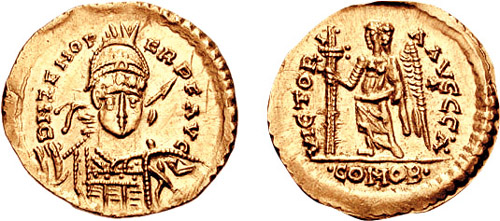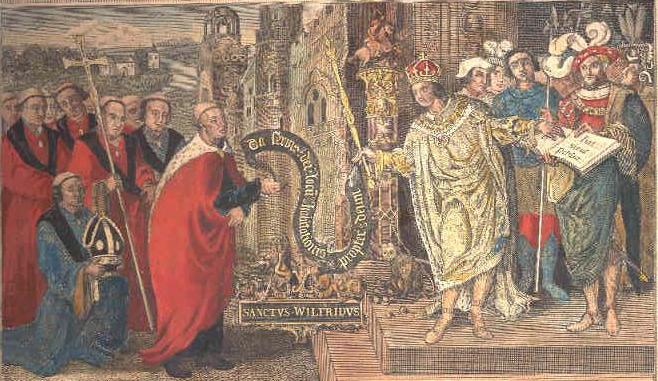|
477
__NOTOC__ Year 477 (Roman numerals, CDLXXVII) was a common year starting on Saturday (link will display the full calendar) of the Julian calendar. At the time, it was known as the Year after the Consulship of Basiliscus and Armatus (or, less frequently, year 1230 ''Ab urbe condita''). The denomination 477 for this year has been used since the early medieval period, when the Anno Domini calendar era became the prevalent method in Europe for naming years. Events By place Africa * January 25 – Genseric, ruler of the Vandal Kingdom, dies a natural death at Carthage, and is succeeded by his eldest son Huneric. He maintains control over the islands in the western Mediterranean Sea with his Vandals, Vandal fleet, and rescinds his father's policy of persecuting the Roman Catholicism, Catholics in Africa (Roman province), Africa. * The independent Mauro-Roman Kingdom (Kingdom of the Moors and Romans) is formed by Christian Berbers in the Roman province of Mauretania Caes ... [...More Info...] [...Related Items...] OR: [Wikipedia] [Google] [Baidu] |
Vandals
The Vandals were a Germanic peoples, Germanic people who first inhabited what is now southern Poland. They established Vandal Kingdom, Vandal kingdoms on the Iberian Peninsula, Mediterranean islands, and North Africa in the fifth century. The Vandals migrated to the area between the lower Oder and Vistula rivers in the second century BC and settled in Silesia from around 120 BC. They are associated with the Przeworsk culture and were possibly the same people as the Lugii. Expanding into Roman Dacia, Dacia during the Marcomannic Wars and to Pannonia during the Crisis of the Third Century, the Vandals were confined to Pannonia by the Goths around 330 AD, where they received permission to settle from Constantine the Great. Around 400, raids by the Huns from the east forced many Germanic tribes to migrate west into the territory of the Roman Empire and, fearing that they might be targeted next, the Vandals were also pushed westwards, Crossing of the Rhine, crossing the Rhine in ... [...More Info...] [...Related Items...] OR: [Wikipedia] [Google] [Baidu] |
Kingdom Of Sussex
la, Regnum Sussaxonum , conventional_long_name = Kingdom of the South Saxons , capital = , era = Heptarchy , status = Vassal of Wessex (686–726, 827–860)Vassal of Mercia (771–796) , government_type = Monarchy , title_leader = Monarchs (see full list) , leader1 = Ælle , year_leader1 = 477–491 or later , leader2 = Æðelwealh , year_leader2 = ''fl.'' , p1 = Sub-Roman Britain , flag_p1 = Vexilloid of the Roman Empire.svg , border_p1 = no , p2 = Kingdom of Haestingas , flag_p2 = , s1 = Kingdom of England , flag_s1 = Flag of Wessex.svg , image_flag = , image_coat = , flag = , flag_type = , coat_type = , image_map = British kingdoms c 800.svg , image_map_c ... [...More Info...] [...Related Items...] OR: [Wikipedia] [Google] [Baidu] |
Genseric
Gaiseric ( – 25 January 477), also known as Geiseric or Genseric ( la, Gaisericus, Geisericus; reconstructed Vandalic: ) was King of the Vandals and Alans (428–477), ruling a kingdom he established, and was one of the key players in the difficulties faced by the Western Roman Empire during the 5th century. Through his nearly 50 years of rule, he raised a relatively insignificant Germanic tribe to the status of a major Mediterranean power. His most famous exploit, however, was the capture and plundering of Rome in June 455. He also defeated two major efforts by the Romans to overthrow him, the first one by the emperor Majorian in 460 or 461, and another by Basiliscus at the Battle of Cape Bon in 468. After his death in Carthage, Gaiseric was succeeded by his son Huneric. Early life and accession Gaiseric was an illegitimate son of King Godigisel and a slave woman. After his father's death in a battle against the Franks during the Crossing of the Rhine, Gaiseric became th ... [...More Info...] [...Related Items...] OR: [Wikipedia] [Google] [Baidu] |
Armatus
Flavius Armatus (died 477), also known as Harmatius, was an Eastern Roman military commander, ''magister militum'' under Emperors Leo I, Basiliscus and Zeno, and consul. He was instrumental in the rebellion of Basiliscus against Zeno, and in his subsequent fall. Origin and early career Armatus was a nephew of Basiliscus and of Empress Verina, the wife of Leo I. It is known that Armatus had a son, also named Basiliscus. During the last part of Emperor Leo's reign, Armatus, as ''magister militum per Thracias'', successfully quelled a revolt in Thrace, cutting off the hands of the Thracian prisoners and sending them to the rebels. It is possible that the rebels were men of the Thracian Goth Theodoric Strabo, a military commander under Leo, and hence this revolt would have been the one started by Strabo between the death of Aspar (471) and the end of Leo's rule (473).Suda, s.v. ''Ἁρμάτιος''. Rise of Basiliscus Armatus supported the rebellion of Basiliscus in 475, proba ... [...More Info...] [...Related Items...] OR: [Wikipedia] [Google] [Baidu] |
Huneric
Huneric, Hunneric or Honeric (died December 23, 484) was King of the (North African) Vandal Kingdom (477–484) and the oldest son of Gaiseric. He abandoned the imperial politics of his father and concentrated mainly on internal affairs. He was married to Eudocia, daughter of western Roman Emperor Valentinian III (419–455) and Licinia Eudoxia. The couple had one child, a son named Hilderic. Huneric was the first Vandal king who used the title ''King of the Vandals and Alans''. Despite adopting this style, and that of the Vandals of maintaining their sea-power and their hold on the islands of the western Mediterranean, Huneric did not have the prestige that his father Gaiseric had enjoyed with other states. Biography Huneric was a son of King Gaiseric, and was sent to Italy as a hostage in 435, when his father made a treaty with the Western emperor Valentinian III. Huneric became king of the Vandals on his father's death on 25 January 477. Like Gaiseric he was an Arian, and ... [...More Info...] [...Related Items...] OR: [Wikipedia] [Google] [Baidu] |
Sussex
Sussex (), from the Old English (), is a historic county in South East England that was formerly an independent medieval Anglo-Saxon kingdom. It is bounded to the west by Hampshire, north by Surrey, northeast by Kent, south by the English Channel, and divided for many purposes into the ceremonial counties of West Sussex and East Sussex. Brighton and Hove, though part of East Sussex, was made a unitary authority in 1997, and as such, is administered independently of the rest of East Sussex. Brighton and Hove was granted city status in 2000. Until then, Chichester was Sussex's only city. The Brighton and Hove built-up area is the 15th largest conurbation in the UK and Brighton and Hove is the most populous city or town in Sussex. Crawley, Worthing and Eastbourne are major towns, each with a population over 100,000. Sussex has three main geographic sub-regions, each oriented approximately east to west. In the southwest is the fertile and densely populated coastal plain. Nort ... [...More Info...] [...Related Items...] OR: [Wikipedia] [Google] [Baidu] |
Onoulphus
Onoulphus, also Onoulf, Unulf and Hunulf (died 493) was a general of the late fifth century of Scirian origin. He served as ''magister militum per Illyricum'' from 477 to 479 as a general of the Eastern Roman Empire, then afterwards was a general for his brother Odoacer, king of Italy, until their death. Biography Onoulphus was a Scirian; with his brother (or possibly half-brother), Odoacer, he was raised at the court of Attila, King of the Huns. Following the destruction of the Sciri, who had been incited to break their treaty with the Ostrogoths by Hunimund, king of the Swabians, Onoulphus with his father Edeko joined the Swabian side in the Battle of Bolia in the late 460s, where they were again defeated by the Ostrogoths under their king Theodemir. Onoulphus joined the Roman army in the 470s and rose through its ranks. He found a protector in the general Armatus, who had him appointed first ''comes'' and in 477, ''magister militum per Illyricum'', commander in chief of the Bal ... [...More Info...] [...Related Items...] OR: [Wikipedia] [Google] [Baidu] |
Zeno (emperor)
Zeno (; grc-gre, Ζήνων, Zénōn; c. 425 – 9 April 491) was Eastern Roman emperor from 474 to 475 and again from 476 to 491. Domestic revolts and religious dissension plagued his reign, which nevertheless succeeded to some extent in foreign issues. His reign saw the end of the Western Roman Empire following the deposition of Romulus Augustus and the death of Julius Nepos, but he was credited with contributing much to stabilising the Eastern Empire. In ecclesiastical history, Zeno is associated with the '' Henotikon'' or "instrument of union", promulgated by him and signed by all the Eastern bishops, with the design of solving the monophysite controversy. The Henotikon was widely unpopular and eventually abandoned under Justin I. Biography Rise to power Early life Zeno's original name was Tarasis, and more accurately ''Tarasikodissa'' in his native Isaurian language ( la, Trascalissaeus).The sources call him "Tarasicodissa Rousombladadiotes", and for this reason ... [...More Info...] [...Related Items...] OR: [Wikipedia] [Google] [Baidu] |
Magister Militum
(Latin for "master of soldiers", plural ) was a top-level military command used in the later Roman Empire, dating from the reign of Constantine the Great. The term referred to the senior military officer (equivalent to a war theatre commander, the emperor remaining the supreme commander) of the empire. In Greek sources, the term is translated either as ''strategos'' or as ''stratelates''. Establishment and development of the command The title of ''magister militum'' was created in the 4th century, when the emperor Constantine the Great deprived the praetorian prefects of their military functions. Initially two posts were created, one as head of the infantry, as the ''magister peditum'' ("master of foot"), and one for the more prestigious cavalry, the '' magister equitum'' ("master of horse"). The latter title had existed since republican times, as the second-in-command to a Roman ''dictator''. Under Constantine's successors, the title was also established at a territorial ... [...More Info...] [...Related Items...] OR: [Wikipedia] [Google] [Baidu] |
Weald
The Weald () is an area of South East England between the parallel chalk escarpments of the North and the South Downs. It crosses the counties of Hampshire, Surrey, Sussex and Kent. It has three separate parts: the sandstone "High Weald" in the centre; the clay "Low Weald" periphery; and the Greensand Ridge, which stretches around the north and west of the Weald and includes its highest points. The Weald once was covered with forest, and its name, Old English in origin, signifies "woodland". The term is still used today, as scattered farms and villages sometimes refer to the Weald in their names. Etymology The name "Weald" is derived from the Old English ', meaning "forest" (cognate of German ''Wald'', but unrelated to English "wood", which has a different origin). This comes from a Germanic root of the same meaning, and ultimately from Indo-European. ''Weald'' is specifically a West Saxon form; '' wold'' is the Anglian form of the word. The Middle English form of the word i ... [...More Info...] [...Related Items...] OR: [Wikipedia] [Google] [Baidu] |
January 25
Events Pre-1600 * 41 – After a night of negotiation, Claudius is accepted as Roman emperor by the Senate. * 750 – In the Battle of the Zab, the Abbasid rebels defeat the Umayyad Caliphate, leading to the overthrow of the dynasty. * 1348 – A strong earthquake strikes the South Alpine region of Friuli in modern Italy, causing considerable damage to buildings as far away as Rome. * 1494 – Alfonso II becomes King of Naples. * 1515 – Coronation of Francis I of France takes place at Reims Cathedral, where the new monarch is anointed with the oil of Clovis and girt with the sword of Charlemagne. * 1533 – Henry VIII of England secretly marries his second wife Anne Boleyn. * 1554 – São Paulo, Brazil, is founded by Jesuit priests. *1573 – Battle of Mikatagahara: In Japan, Takeda Shingen defeats Tokugawa Ieyasu. * 1575 – Luanda, the capital of Angola, is founded by the Portuguese navigator Paulo Dias de Novais. * 1585 – Wal ... [...More Info...] [...Related Items...] OR: [Wikipedia] [Google] [Baidu] |
Cymenshore
Cymenshore is a place in Southern England where, according to the ''Anglo-Saxon Chronicle'', Ælle of Sussex landed in AD 477 and battled the Britons with his three sons Cymen, Wlencing and Cissa, after the first of whom Cymenshore was held to have been named. Its location is unclear but was probably near Selsey. Historical context Foundation myths The account of Ælle and his three sons landing at Cymenshore appears in the ''Anglo-Saxon Chronicle'', a collection of seven vernacular manuscripts, commissioned in the 9th century, some 400 years or more after the events at ''Cymenshore''. The legendary foundation of Saxon Sussex, by Ælle, is likely to have originated in an oral tradition before being recorded in the ''Anglo-Saxon Chronicle''. According to the ''Anglo-Saxon Chronicle'' ''Cymenshore'' is named after ''Cymen'', one of Ælle's sons. From 491 until the arrival of Christianity in the 7th century, there was a dearth of contemporary written material.Because of the lac ... [...More Info...] [...Related Items...] OR: [Wikipedia] [Google] [Baidu] |



.jpg)

.jpg)


